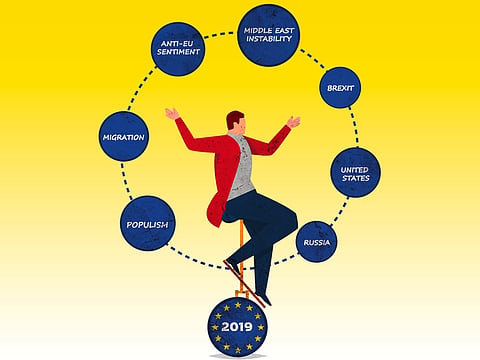EU prepares for a tough 2019
A high-risk environment and geopolitical realities pose challenges for European alliance

As 2018 transitions to 2019, the European Union (EU) could well be facing another choppy year. Storm clouds are gathering again not only from the Brexit ‘endgame’, but also over Italy’s Eurosceptic coalition government and the populist surge in Eastern Europe, including Hungary and Poland.
The contrast with only just over 12 months ago is striking, when in September 2017 European Commission President Jean Claude Juncker had asserted that the “wind was back in Europe’s sails”. Then, after a bad 2016 for the continent, not least with the United Kingdom’s EU referendum, Brussels was upbeat following a spate of positive political and economic news.
Not only had Eurozone economies then recorded significantly improved growth, but also voters in France and the Netherlands had rejected far-right populists lifting the political mood. Yet, Juncker rightly warned in his speech that the then good news window “won’t stay open forever”.
Fast forward to the end of 2018, and the prescience of Juncker’s warning is clear. Last June, he was forced to admit that “the fragility of the EU is increasing. The cracks are growing in size” after the Summer European Council summit of presidents and prime ministers struggled to arrive at a deal on the migrant crisis after German Chancellor Angela Merkel’s political future was threatened.
The fragile agreement then saw a number of EU countries agreeing — on a voluntary basis — to take in migrants rescued from the Mediterranean Sea. However, no agreement was reached on refugee quotas with several states holding out against language that this should be a compulsory EU-wide responsibility.
This exposed divisions with Germany and France pushing hard for a comprehensive way through the impasse, while others like Hungary and Italy — run by populist leaders — became much more sceptical. This latter harder-line stance was exemplified in Hungary in June when the nation’s parliament passed laws to criminalise any individual or group offering to help asylum claimants, following that nation’s Prime Minister Viktor Orban’s landslide re-election in April.
These ongoing European tensions over asylum and immigration will coincide in 2019 with the scheduled end-game of the two-year Article 50 Brexit negotiations. With the exit process having consumed a massive amount of time of both London and Brussels in 2017 and 2018, the first weeks of the New Year will be decisive in determining how the political drama will play out, including whether a withdrawal deal is agreed, or not.
Beyond Brexit, the gathering storm clouds across the continent highlight the fragility of the political situation in the EU as shown not just by the election of Italy’s Eurosceptic coalition government earlier this year; the weakening of Merkel’s government in Germany; and the growing populist surge in eastern Europe.
Summing up the challenges, European Council President Donald Tusk has remarked that the risk environment now facing the EU are perhaps the “most dangerous than ever” with three key problems “which have previously not occurred, at least not on such a scale”. According to Tusk, the first two threats relate to the rise of anti-EU, nationalist sentiment across the continent, plus the “state of mind of pro-European elites” which Tusk fears are too subservient to “populist arguments as well as doubting in the fundamental values if liberal democracy”.
While Brexit exemplifies, from Tusk’s perspective, these challenges, the problem is by no means limited to the United Kingdom. Indeed, Emmanuel Macron admitted earlier this year that even France, one of the two traditional motors of EU integration alongside Germany, would probably vote to leave the EU if presented with a similar choice to UK’s 2016 referendum.
And if these issues were not big enough, the third threat cited by Tusk is what he calls the new geopolitical reality that has witnessed an increasing assertive Russia, and instability in the Middle East and Africa which has driven the migration problems impacting Europe. And intensifying this is uncertainty from Washington with Donald Trump previously calling for more Brexits across the continent.
While Trump is widely criticised across the continent, his message has secured traction with several governments. New Italian Prime Minister Giuseppe Conte, for instance, has emerged as his strongest supporter in Western Europe.
This populist political affinity is reflected in the alignment on key issues like Russia and immigration with Conte asserting that both “governments [in Rome and Washington] represent change, they were chosen ... to change the status quo”. While the Italian government has so far largely kept its powder dry with Brussels, 5 Star Leader Matteo Salvini says he wishes the nation to leave the EU, while coalition partner The League has called for a referendum on whether Italy should remain in the Euro single currency area.
Taken overall, while some in Brussels sensed in 2017 that the Eurosceptic wave had passed its peak, storm clouds are gathering again as 2018 ends. Decisions in 2019 will help define the EU’s longer-term political and economic character in the face of wide-ranging internal and external challenges, including Brexit.
Andrew Hammond is an Associate at LSE IDEAS at the London School of Economics.
Sign up for the Daily Briefing
Get the latest news and updates straight to your inbox



